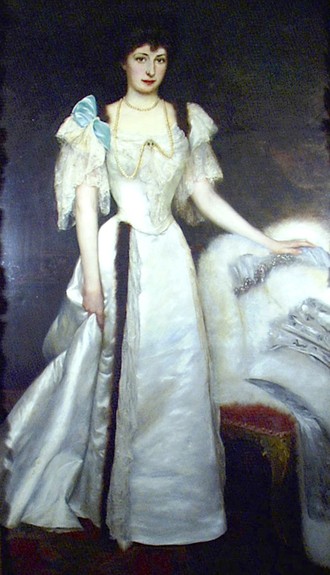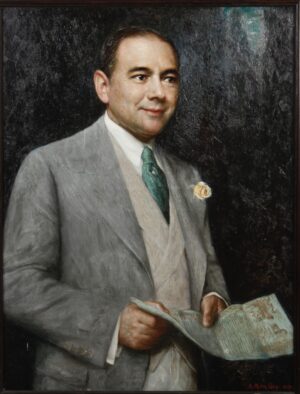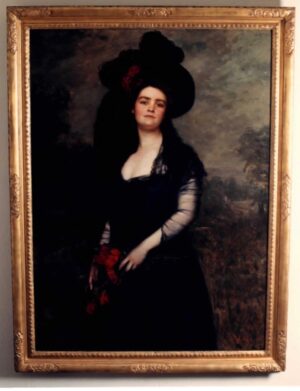DAHLGREN, Elizabeth Drexel
Description:
Full-length, standing beside a chair covered in an ermine-edged cloak, dressed in brown fur-edged white satin with train. Oil on canvas, 79” x 46” (200.7cm x 16.8cm).
Location:
Georgetown University, Washington D.C. 20007, U.S.A.
Provenance:
Gift of John Vinton Dahlgren after 1898, but see notes below.
Bibliography:
New York Herald, Sunday, February 13, 1898
New York Times, May 14, 1899 (reproduced)
New York World, October 22, 1899
Washington Times, October 23, 1899
North American, Philadelphia, May 19, 1900
Fremont Rider and Frederic Taber Cooper, Rider’s Washington: A Guide Book for Travellers, 1924, p.468.
Collection Catalogue, 1963
She was born on April 22, 1868 in Philadelphia to Lucy Wharton (1841–1912) and Joseph William Drexel. Joseph was the son of Francis Martin Drexel, the immigrant ancestor of the Drexel banking family in the United States. The sitter was their second daughter. She and her husband, who were married in 1889 at the Maryland home of the bridegroom’s mother, Mrs. Madeleine Vinton Dahlgren, and at the time that Muller-Ury painted her portrait lived in New York at 20, West Fifty-sixth Street. When Dahlgren died early in the new century she married Harry Lehr in 1901. Lehr was almost certainly homosexual, and the marriage was in consequence a sham. When Lehr died in Baltimore in 1929, Bessie Drexel Dahlgren Lehr married an English baron, Hope de la Poer Beresford, Lord Decies, and lived in France. Elizabeth published two books, “King Lehr” and the Gilded Age (1935) which tells the story of her unhappy 28 year marriage to Lehr, which was referred to as a “tragic farce”; and Turn of the World (1937) a fascinating semi-autobiographical history of American high society during the 1890s up to 1914. She died on June 13, 1944.
The sitter was the donor of the Chapel of the Sacred Heart at Georgetown University. (It should be noted that the cuttings in the artist’s papers indicate she presented the portrait to the University herself.) However, in the Special Collections section of the Lavinger Library at Georgetown University are two letters one of which is certainly related to the Muller-Ury portrait:
‘A.M.
Jan 27/98
My dear Fr. Richards:
Last summer you suggested to me that the University would like to possess a Portrait of Mrs Dahlgren. If your Board of Director[s are possessed of] the same mind I will present to it such a work by one of the most distinguished artists in the country. I speak of Mr Muller Ury. The character of the picture will be such as will befit the dignity of an institution of learning.
Some days since I saw Mr Thoarms of Hess & Co, and directed him when next in Washington to visit the Chapel, and determine upon the proper decorations of the walls. Trusting that this order will meet with your approval I am as ever your sincere friend
John Vinton Dahlgren’
Muller-Ury had evidently begun the portrait when the New York Herald, Sunday, February 13, 1898, reported that she was ‘sitting, or, rather, standing as the picture is to be almost full-length and life-size. Mr Muller-Ury is the painter and when completed the picture is to be given to Georgetown College.’ Muller-Ury sailed for London two months later on April 12 with the Seilerns and Mrs Herman Oelrichs and Miss Virginia Fair. This was presumably time enough to complete the portrait; he did not return to New York until December.
In the meantime the sitter’s husband wrote, on black-edged mourning paper, from Saratoga on August 16, 1898 (fragment, same source) as follows:
‘Rev. John Whitney
President of Georgetown University
My dear Fr. Whitney
I write with regard to the picture of Mrs Dahlgren, now hanging in one of the front drawing rooms. It was my intention, had this painting been a success, to present it to the College. Both Mrs Dahlgren and I, however, are not pleased with it, and have decided not to part with it. It was sent to the College entirely on the responsibility of the artist, who did so without consulting me. I will feel under obligation to you if you will have it boxed up, and stored in some room in the College until I return to N.Y. when I would like it expressed to me. Whatever this may cost the College pray let me know, and I will take pleasure in paying the…’ Unfortunately no correspondence survives to explain matters further, but interestingly this is the very time when he displeased Margaret Daly over the portraits of her daughters Margaret and Mary.
Evidently the Dahlgrens did not appreciate the fact that Muller-Ury did not ask to send the portrait to them first though for him it was probably a practical solution to send it to where he had been told it was destined to hang as he was leaving for Europe. Perhaps in the late summer of 1898 the college authorities that had evidently hung the portrait, persuaded Mr. and Mrs. Dahlgren of the portrait’s merits and requested to keep it. When Muller-Ury returned to New York at Christmas he would have heard what had happened. We do not know if he been paid for the picture by then.
After the portrait was reproduced in the New York Times, May 14, 1899, it may possibly have been difficult for the Dahlgrens to continue their disagreement, but they probably did so. But when Muller-Ury’s portrait of General Grant was presented to the Corcoran Gallery on May 4, 1900, they must have decided to accept the status quo, for Mrs Dahlgren quickly gave it to the University as stated in the North American, Philadelphia, May 19, 1900, where there is the added comment, ‘The work has been highly complimented by local artists, and is greatly appreciated at the University.’
Rider’s Washington, 1924, states, ‘In the N. parlor is a full-length portrait of Mrs. Henry S. Lehr, by Muller-Ury.’



![OELRICHS, [Natalie] Lily (Later Mrs Peter Martin; Later Duchess of Mecklenburg)](https://www.muller-ury.com/wp-content/uploads/2018/11/digiScanLtd.com-Conrad69-1-300x511.jpg)

